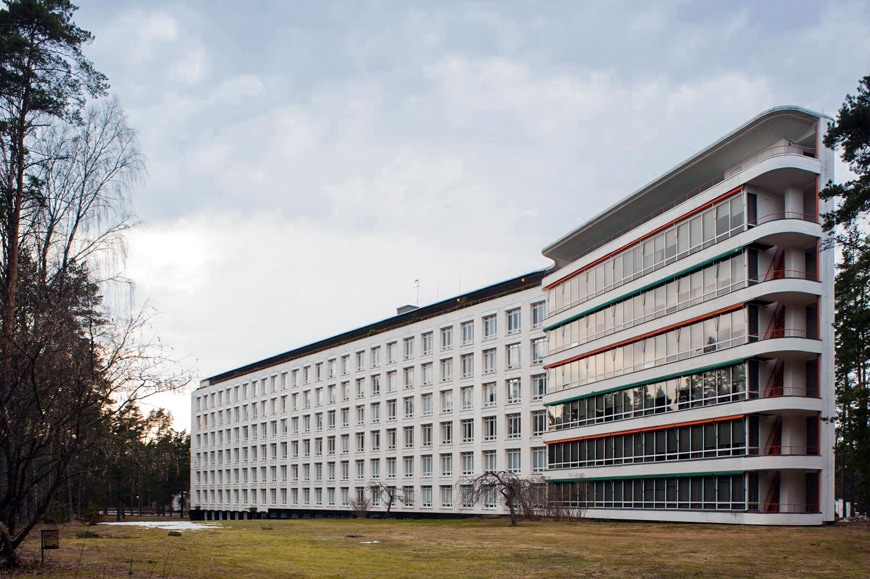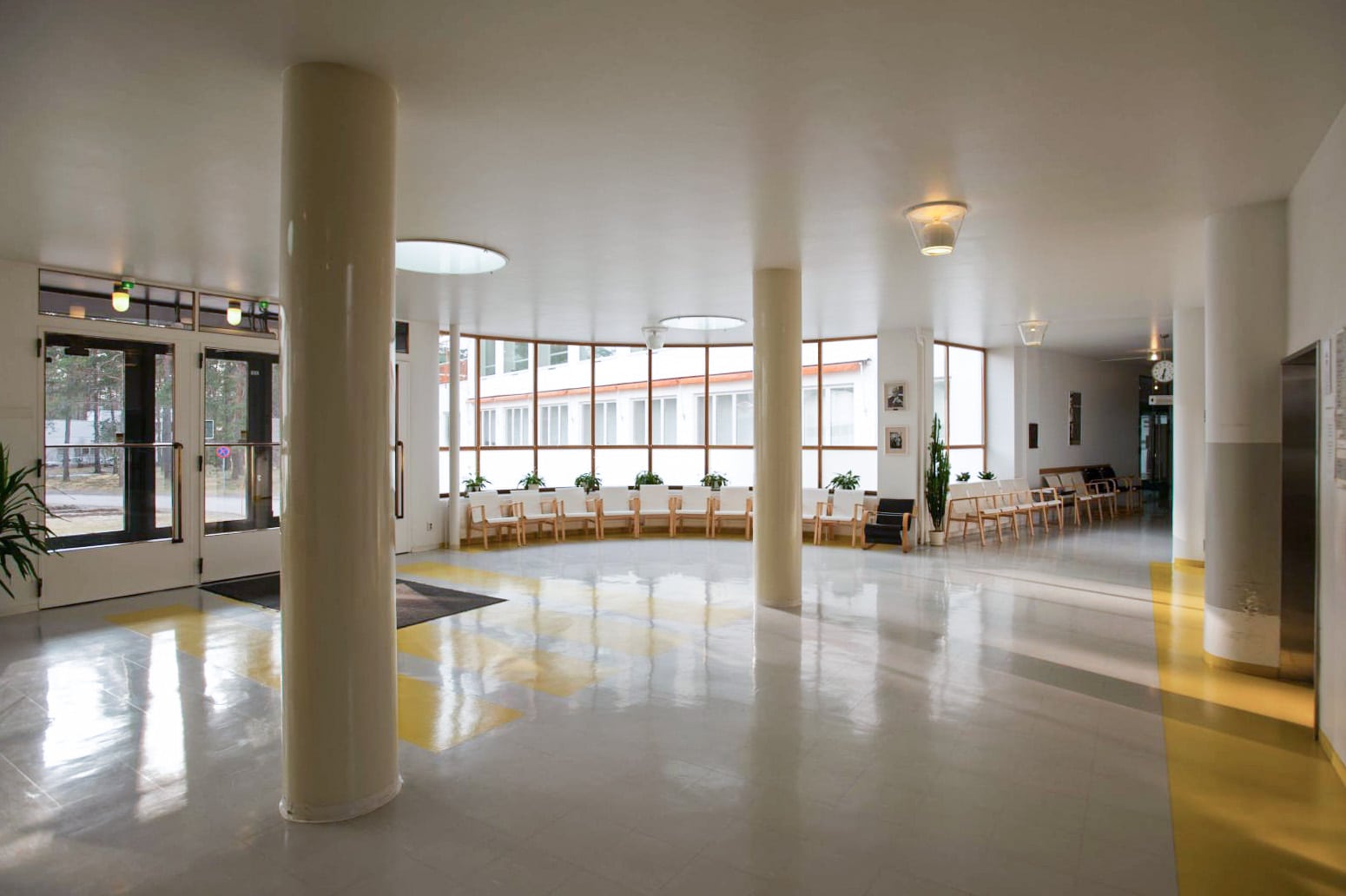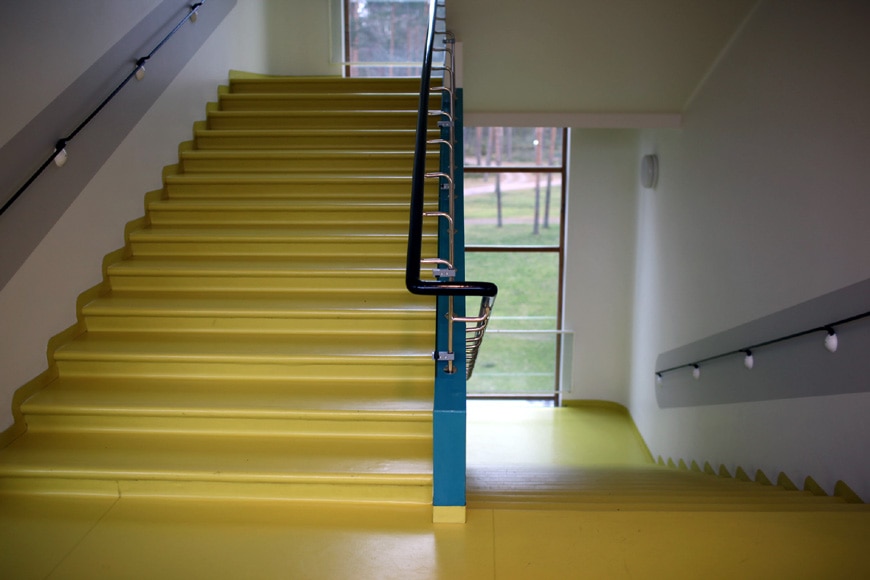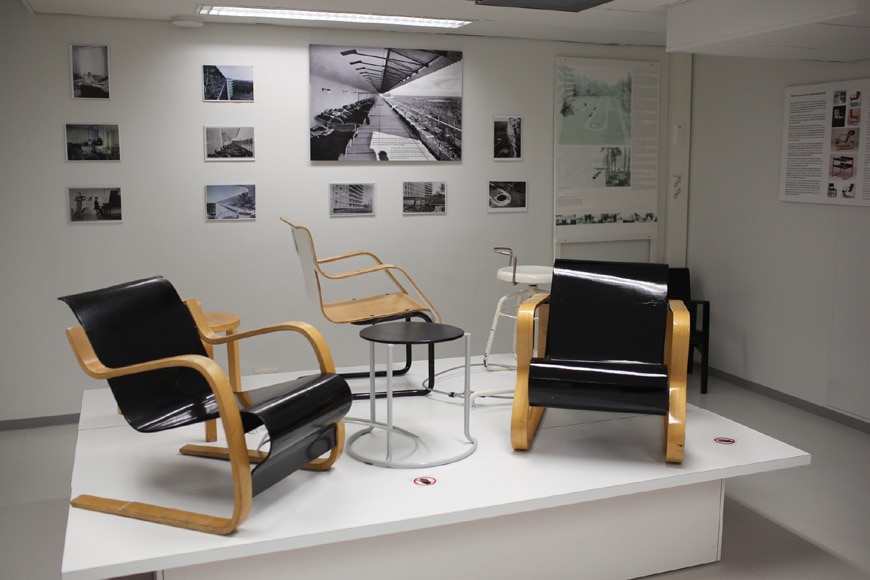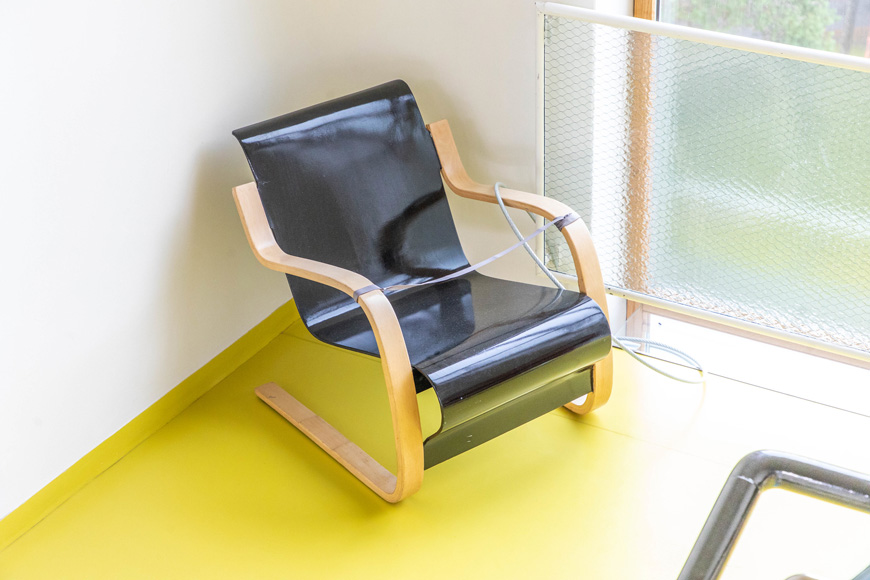Aalto’s Paimio Sanatorium and the birth of the modern hospital
Photos: see captions
The Paimio Sanatorium, patients’ wing, exterior view from the southeast; photo Leon/Flickr CC BY 2.0
Designed by Alvar and Aino Aalto in 1929, the Sanatorium of Paimio, Finland, is widely regarded as the first example of modern architecture applied to healthcare.
Introduction
Sanatorium is a Latin word commonly used to identify healthcare centers for the treatment of tuberculosis, an infectious disease and a terrifying plague that took the lives of millions of people, including Jane Austen, George Orwell, Franz Kafka, Frédéric Chopin, Molière, and Eleanor Roosevelt, among many others. Even today, despite the introduction of antibiotics and vaccines, has made the disease uncommon in the Western world, tuberculosis still causes a high number of deaths in developing countries, especially in Africa and South Asia.
Between the mid-18th century and the early 20th century, the disease peaked in northern Europe where the cold climate, urbanization, and poor hygienic conditions of the time made its impact devastating; at the beginning of the 20th century, tuberculosis was the most important single cause of death in Finland *.
The Finnish government reacted with a program to build new sanatoriums throughout the country and, in 1929, organized an architectural competition to design a sanatorium amid a pine forest in Paimio – a small town near Turku, in Southwestern Finland.
The entry by Alvar Alto and his wife Aino, then 31 and 35-year-old respectively, eventually won the competition. The new facility was aimed to serve the 52 municipalities of the Federation of Southwest Finland.
At the time, sanatoriums were facilities in which, before the invention of the Streptomycin antibiotic, people infected by TB and other pulmonary diseases were segregated from the population and treated, sometimes for several years, mainly with sunbaths, fresh air, a nutritious diet, exercise and rest.
Since the centers had a two-fold scope – on the one hand, to isolate the infectious patients from the population and, on the other hand, to cure them – they were either characterized by a prison-style architecture or a hospital-like one, alternatively.
The Aaltos enthusiastically embraced the latter and conceived the Paimio sanatorium as an “instrument for healing”. Furthermore, they applied then-innovative architectural concepts to the facility, creating one of the world’s first examples of modern healthcare architecture. >
Along with the building, the Aaltos also designed the sanatorium’s furniture and tableware, thus conceiving a sort of total artwork aimed at improving people’s health and well-being in a peaceful environment.
The Paimio Sanatorium, exterior view; photo Jussi Toivanen/Flickr CC BY-NC-ND 2.0
The architecture of the Paimio Sanatorium
Completed in 1933, converted into a hospital in the 1960s, and now largely unused, the main building of the former sanatorium consists of three wings, one originally accommodating the patients, one for various technical facilities, and the entrance/communal wing in between. All wings share a common basement level containing several technical facilities.
It has to be said that the final design was slightly different than Aaltos’ competition entry since the client required the architects to add 100 more beds to the patient wing, thus making it much larger and dominant than originally planned.
The patient wing (called A-wing) is a seven-story reinforced concrete construction topped by a 100-meter-long sun deck. The wing contained 1,2, 3, and 4-bed rooms for a total of 296 beds. Each room has a south-facing window allowing sunlight into the interior space. Since fresh air was part of the patients’ treatment, the Aaltos also designed an ingenious natural ventilation system that exploited the difference of pressure between the wing’s lower and the upper floors, complemented by more traditional opening windows and electrical exhaust vents. Natural ventilation over a centralized mechanical ventilation system was preferred mainly to avoid the possible spread of infectious bacteria through common ventilation ducts. The rooms were also equipped with a radiant-ceiling heating system.
Six 24-bed balconies for heliotherapy (later converted into offices) were located, stacked on one another, at the eastern end of the wing. The 120-bed sun terrace on the top floor complemented them. A garden with pines, artificial ponds, play games, wildflower meadows, and gravel paths was located south of the wing to provide the rooms with a view and to allow patients to walk in a safe and relaxing natural environment.
Along with the main entrance hall, the entrance wing (also known as B-wing) contained communal spaces, including the sanatorium’s dining hall, the library, and workrooms, together with other spaces, such as an operating theater, an X-ray room, treatment rooms including an artificial sun treatment room, laboratories, and offices for the medical staff.
The C-wing housed the kitchen, and a boiler room located in an annex volume (sometimes called D-wing).
One of the patient’s rooms with the original furniture. Photo Leon/Flickr CC BY 2.0
The entrance hall; photo Leon/Flickr CC BY 2.0
Internal view. Photo Jussi Toivanen/Flickr CC BY-NC-ND 2.0
The roof terrace today. Photo Jussi Toivanen/Flickr CC BY-NC-ND 2.0
The use of color
In the early 20th century, most hospitals and sanatoriums were characterized by a rather crude “functionalist” architecture usually painted in white and light gray because of the idea of a “clean and hygienic” environment those colors suggested.
Alvar and Aino Aalto, in collaboration with artist Eino Kauria, subverted that paradigm by introducing colors throughout the sanatorium. Unfortunately, the original colors have been covered and/or altered over time; yet, a painting by Kauria and a detailed research study by Elina Riksman for the Alvar Aalto Foundation ** give us a rather precise idea of what they were. For example, yellows were used in the main hall, many communal areas, and the staircases; reds in the dining hall, the artificial sun treatment room, and for all heating pipes; orange for the X-ray room; soothing colors, such as bright greens and light blues, were used for the ceiling of the patient rooms, the lounge, the library, and in the operating room; the corridors of the wards were painted in green, blue, and ochre orange.
The Aaltos did not intend the use of color for merely aesthetic reasons, they believed instead that the psychological effects that different colors produce on people could play a role in the therapy; therefore, they used cold, calming colors in the rooms where the patients had to stay for long hours and warm, energetic colors in many circulation and communal spaces.
Such use of colors, largely unprecedented in the 1930s, is widely accepted, even mandatory, in the design of today’s hospitals and healthcare facilities.
The yellow-painted staircase in the main building. Photo Leon/Flickr CC BY 2.0
photo Jussi Toivanen/Flickr CC BY-NC-ND 2.0
Furniture design
As mentioned, the Aaltos designed many objects for the sanatorium. The most famous of them is arguably the Paimio Chair. Manufactured subsequently by Artek, the furniture company founded by the Aaltos in 1935, the chair was intended for the patients’ relaxation in the sanatorium’s lounge and consists of two laminated-wood loops and a thin curvilinear steam-bent birch plywood seat. One of the most iconic designs of the 20th century, the Paimio Chair is still in production.
Other objects specially designed for the facility include dining chairs, tables, stools, beds, and various light fixtures – ceiling lamps, wall lamps, table lamps, and outdoor lamp posts.
Alvar and Aino Aalto also created a bowl-shaped washbasin in porcelain, designed to minimize the noise of running water and not disturb the neighbors.
Some of the pieces of furniture designed by Alvar and Aino Aalto for the Paimio Sanatorium: the Paimio Chair (model 41), the “small Paimio” armchair (model 42), a cantilever chair (model 26), and two stools. Photo Jonas Forth/Flickr CC BY-ND 2.0
Paimio Chair, photo Jussi Toivanen/Flickr CC BY-NC-ND 2.0
A spittoon designed by the Aaltos for the sanatorium; photo Jonas Forth/Flickr CC BY-ND 2.0
* Ida Blom, Contagion and Cultural Perceptions of Accepted Behaviour Tuberculosis and Venereal Diseases in Scandinavia c.1900–c.1950, 2007, Hygiea, p.126
** Elina Riksman, Paimio Sanatorium Colour Research 2015, Alvar Aalto Foundation
copyright Inexhibit 2025 - ISSN: 2283-5474

